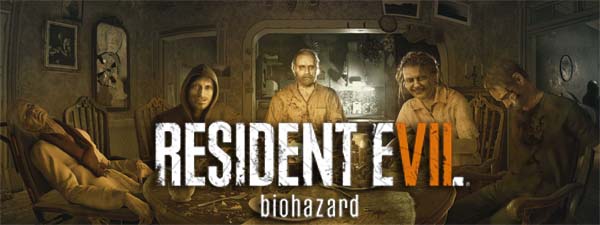
It's been a long time since I've given a crap about Resident Evil. I loved the classic Resident Evil games. The Play Station original is a foundational game for me, and jump-started my interest in horror and the macabre. I felt like the series jumped the shark with Resident Evil 4, however, and my interest in the series tanked with its abandonment of horror in favor of schlockey action-shooter gameplay. I played through Resident Evil 5's co-op with a friend, but didn't really enjoy myself, and after playing the abysmal demo for RE6, I skipped that one entirely.
So I was genuinely excited by Resident Evil VII: Biohazard. The popularity of first-person horror games, and the phenomenon that was P.T. / Silent Hills (not to mention the success of Resident Evil REmastered on Steam) obviously seems to have kicked Capcom in the butt and reminded them that there is still an audience for genuine horror games - an audience that mainstream gaming has neglected for most of the last decade. I'm not sure if development of REVII started as a response to P.T., or if it was already in the works following the success of games like Amnesia, Outlast, and Alien: Isolation. Either way, it's good to see major publishers embracing the genre again.
The family's new - but familiar - mansion
This new Resident Evil really does go back to the franchise's roots. The early hours of the game actually feel a lot like a combination of the original Resident Evil and Resident Evil 3: Nemesis, but updated with a first-person camera and a lot of modern horror contrivances. Long-time fans of the series will recognize the safe rooms and item-boxes. The classic health status indicator is now part of a watch on the character's wrist that you can see whenever you pull up your inventory. There's a foyer with a balcony. Doors are locked by silly, esoteric puzzle mechanisms that require themed keys, crests or various other stand-ins for keys. There's even a booby-trapped shotgun to tease you at the start of the game. Some of these elements of design feel appropriate, while other ham-fisted call-backs admittedly feel like the developers were trying too hard.
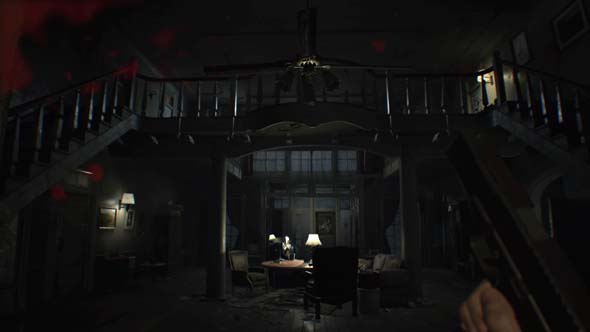
The mansion is new, but has many call-backs to the first game.
The map is well-designed, with its claustrophobic hallways, shortcuts, and lots of visual detail. Lighting is excellent, though the game is a bit too dark at the recommended brightness level (at least without a flashlight), and it becomes washed-out at higher brightness settings. Sound design is also quite exceptional, with the game giving great audio feedback (especially for the pursing stalkers). I also like a lot of the little details, particularly how using a key to unlock a door takes a small amount of time, during which you are vulnerable.
The family also makes for some excellent antagonists, especially compared to the likes of stupid, campy villains like Albert Wesker and Salazar. These villains have a lot of character, and there's enough detail in the mansion to give a sense of who these people might have been before they went off the deep end: the collectible football bobbleheads, for example. And on top of that, they are genuinely disturbing and threatening, and the whole game would probably be scary enough if you just spent the whole time avoiding them and trying to escape their murder house.
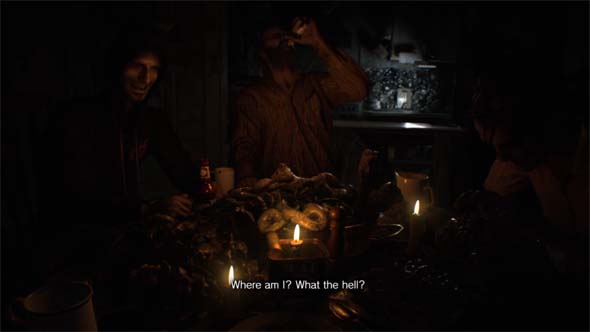
The family makes for genuinely disturbing villains that put RE's earlier villains to shame.
The save system is kind of an odd hybrid of the classic save system and more modern checkpoint systems. The logistics of the classic system have been scaled back, as you no longer require a consumable item (ink ribbon) to manually save (at least not on the default difficulty). But the game will also checkpoint you at certain points, and it maintains a single autosave slot with your checkpointed progress. So if you die to one of the obnoxiously-hard bosses, you don't have to go back a whole hour to your last manual save; instead, you get to restart at the most recent checkpoint.
However, the manual saves still have value, because Biohazard is structurally very similar to the original Resident Evil - both superficially and in terms of gameplay... [More]
a4e07563-fcc1-4e63-88fa-f5d8f517792b|1|5.0
Tags:Resident Evil, Biohazard, Resident Evil 7: Biohazard, Capcom, horror, survival horror, shooter, first person, inventory, resource management, mansion, autosave, save system, puzzle, logistics
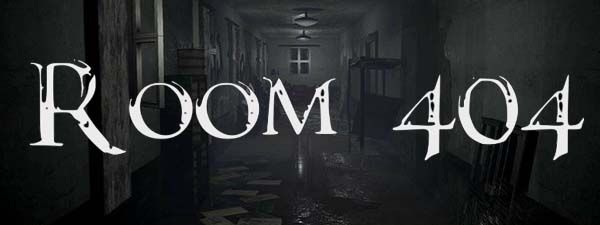
Since I'm in between major releases, it's time for yet another indie Steam game. This time, it'll be a game that was released this year! Only a few weeks ago, in fact! I picked up Room 404 (along with a couple handfuls of other games) in the Steam Summer Sale a couple weeks ago. It's yet another attempt to scratch that horror itch that was left behind by the cancellation of P.T.. Room 404 completely failed to scratch that itch.
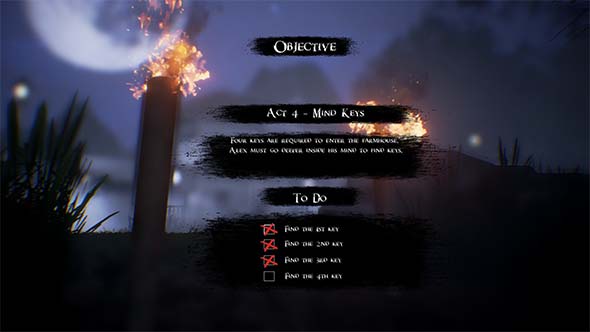
Practically the whole game consists of walking around collecting keys. Not very scary...
There's really not much to this game at all. It's only a couple hours long and isn't very mechanically or intellectually substantive. It falls firmly into the category of "walking simulator", and even that might be generous. There's basically three types of puzzles that get re-used throughout the game - if you can call them "puzzles", that is. All of them are resolved by simply exploring the linear areas to find the triggers to solve the puzzle. Numeric keypad locks are opened by searching adjoining hallways and rooms for the numbers that make up the combo, which are hidden in plain sight or in obvious locations. If you're not looking for keypad numbers, then you're looking for simple keys. The second puzzle type involves simply lighting candles in the right order. The final puzzle (which only appears once) puts you in a tiny maze and shows you a map that highlights your current location and the location of the exit. You turn three corners, and you're done.
Some of these puzzles are made a little bit confusing by the game's only real feature: its changing landscape. At several points in the game, you'll come across a locked door or obstacle, which will force you to turn around to find that your environment has changed. In some cases, this will mean that another door will suddenly be open, allowing you to explore a previously-closed off room. In other cases, you simply turn back around to find the obstacles gone. These situations are always accompanied by an audio cue to notify you that something has changed, and the sound of a creaking door will often notify you to go back and check previously-closed doors. In other cases, it's not always obvious what you're supposed to do, and I swear at least a couple puzzles were solved by my simply turning around in circles a couple times wondering what the heck the game wanted me to do.
Puzzles don't get any more complicated than finding keys and numbers hidden in plain sight.
There is an enemy in the game that can kill you on contact, just like in so many other "run and hide" horror games. However, in this case, you can't actually run or hide... [More]
30d421b7-c35e-4626-8f21-2b3bc34eef7d|0|.0
Tags:Room 404, 3DTM, Machine Bear Software, Steam, Steam Greenlight, psychological horror, horror, indie gaming, hotel, murder, father, son
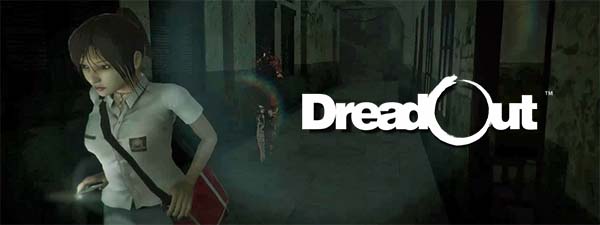
The opening moments of DreadOut set the bar pretty low for what was to come. The visual quality varies wildly. The main character, Linda, looks and animates decent enough, but the other characters all look incredibly stiff and robotic. And they sound almost as stiff and robotic. I'm not sure if it's a matter of poor translation, cultural disconnects, or if it's a deliberate attempt by the developers at camp, but the dialogue and voice acting is cringe-worthy. It wasn't even laughably bad. It was just bad. Don't worry though, you won't have to put up with them for long. They'll disappear for the majority of act 1, rendering the game's futile attempts at early character-building moot, and likely leading to you forgetting that they ever existed until they reappear later. The ghosts and monsters themselves actually get better development and depth, as each one is given a thematic backstory, and its aesthetic design attempts to represent that theme - with varying degrees of success.
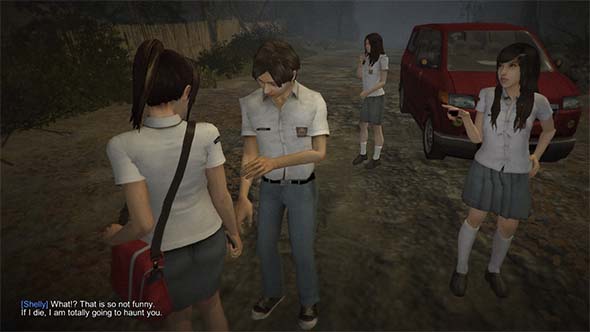
Dialogue and voice-acting might have been going for deliberate camp, but ends up just being bad.
It's an indie game, so I don't expect its graphics to impress on any technical level. But what's presented on screen is often only passable for a PS2-era game, and there's very little artistry or detail in the majority of environments. Some of the environments are decent, and there's the occasional well-placed lighting or particle effect that helps to set a mood. That mood rarely lasts though, because you'll turn a corner and find repetitive environments and flat textures. It is very easy to get lost in a few areas of this game because so much of the environment looks the same. The school building was particularly bad, as all the classrooms had the same desks, chairs, and backpacks sitting around. Only two rooms in the entire building had unique decorations (a teacher's office and what appeared to be a biology lab). The difficult-to-read signposts and lack of any sort of in-game map just exacerbates the sameness of the game's environmental design.
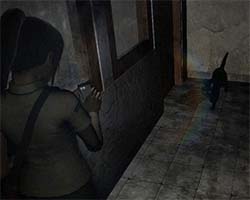
"Aw, hello Mr. Kitty!"
Oh, you're a black cat and are
supposed to be scary. My bad..
Gameplay is less a mixed-bag, and is more universally terrible. Movement is very clunky. The camera loves to pivot around when you go through doors, leading to temporary disorientation as you try to figure out which direction the character is facing. It doesn't help that so much of the game looks the same, so it's easy to get turned around and confused (or outright lost) when the camera wigs out on you.
There's a blue vignette effect that indicates a nearby item that is designed to work as a player aid, but sometimes it can be a hindrance. It works through walls, which I guess is fine since it can let you know that you need to go into a nearby room. What isn't fine is that it also seems to work through floors and ceilings. So the game will nag you that a useful item or clue is nearby, but it might be on a different floor of the building. So you end up wandering back and forth trying to find it - which you never will because it's not there... [More]
175d6d05-3fa8-4f7e-ad1b-458c00a80c3c|4|3.5
Tags:DreadOut, Digital Happiness, horror, indie gaming, Steam, Indonesia, ghost, school girl, camera, cell phone, photograph
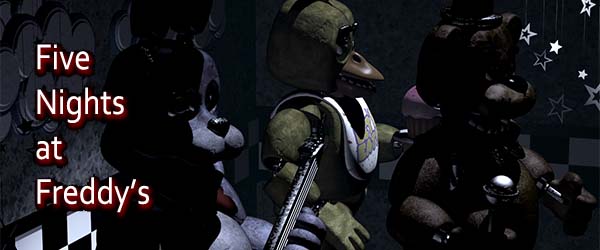
Five Nights at Freddy's was recommended to me by some friends a couple years ago. They knew that I was interested in horror games, and that I was disappointed with the stock of horror games that were available at the time. I bought it at the time, but never got around to playing until recently.
The concept for the game is quite a good one. You work as a night watchman of a Chuck E. Cheese-style children's birthday party center. By day, there's four animatronic animals along the lines of Disney's Country Bear Jamboree that dance and sing songs to entertain children; but by night, these animatronic animals come to life, stalk the halls of the facility, and have been known to attack and kill anybody that they find. This is definitely the stuff of nightmares, and if your young child ever plays the game (or sees you playing it), he or she might never want to go to Chuck E. Cheese or Disneyland ever again. But as an adult, the game just doesn't quite do it for me.
I think the core problem is that the whole experience is built around providing semi-random jump scares. It might cause someone to jump the first one or two times it happens, but after that, you get pretty quickly desensitized to it. And once that happens, the game loses all of its effectiveness, even though it doesn't necessarily lose any of its borderline-unfair challenge.
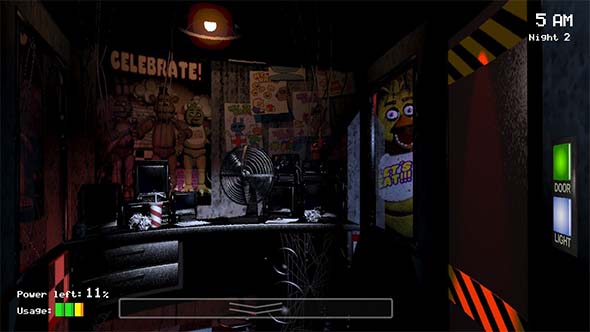
Keeping the security doors closed consumes power, sacrificing your long-term security.
You must spend five nights sitting in a security control room. There's two security doors and a series of camera, but there's also a limited supply of dwindling power. Closing the doors consumes power, looking through the cameras consumes power, turning the lights on consumes power. And if power runs out, you are left sitting in the dark for the rest of the night with no defense against the monstrous mechanical mascots.
The amount of nightmare logic that is required just to establish the setting is actually kind of interesting in its own right. What kind of a place operates with dwindling power? How poorly-maintained is this facility? How does it maintain power during the day? Is it even safe for kids during the day? Why would the doors require power to stay closed? You also get voicemails each night from the former night watchman, who casually talks about the increasingly-complex behaviors of the mascots, new strategies for dealing with them, and so on. These phone messages are very well-acted and well-delivered. All of this contributes to the game's incredible uncanny setting, and everything seems to be in the perfect place to create an incredible horror experience based on powerlessness and creeping tension.
But then the actual gameplay starts, and the excellent atmosphere starts to buckle... [More]
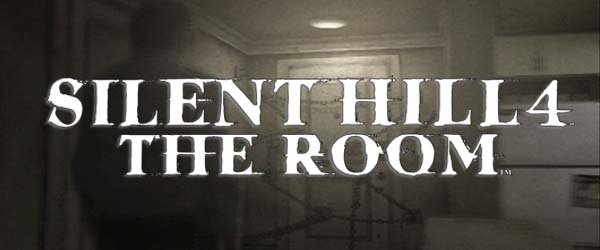
While I was playing through recent horror titles like The Evil Within, I noticed some interesting similarities with Silent Hill 4 that started to give me a new appreciation for some of this game's stronger aspects. In addition, while doing research for my Silent Hill timeline, I had to go back and play through Silent Hill 4: the Room again. I had only played through the game twice before, so I had to replay it in order to figure out how the timeline would work out. And while I was playing the game, I figured that I might as well go ahead and review it. At the time, it seemed like a novel idea to do a retro review of a Silent Hill game that wasn't Silent Hill 2, but lately, I've been seeing a lot of retro-reviews of The Room popping up other places. I haven't done any retro reviews yet; probably the closest thing has been my review of Demon's Souls. But in light of how unsuccessful the later Silent Hill games have been, the unfortunate cancellation of Silent Hills, and the uncertain future of the franchise (and of Konami as a studio), it's a good time to go back to look at what worked and what didn't about the previous games, and explore the question of whether we even want the franchise to continue.
The Room has the reputation of being the "bad" black sheep of the original Silent Hill tetralogy. I always thought that this reputation was unfortunate, and that the game wasn't quite as bad as people made it seem. I actually liked it better than Silent Hill 3 when I first played it, because I had never played the first Silent Hill. After I was able to track down a copy of the first game and play through it, Silent Hill 3 suddenly made a whole lot more sense, and I came to love it almost as much as I loved Silent Hill 2. So while I tend to agree that The Room is the "weakest" of the original Silent Hill games, I never really thought of it as being "bad"; just "less good". The release of future games by third party developers has only made The Room look better in retrospect.
An experimental formula
The game itself is a bit rough around the edges. It deviates significantly from the controls and mechanics established by the previous games in the franchise, and these changes are very hit-or-miss. This might be due, in part, to the possibility that The Room started out as an independent side project that was developed concurrently with Silent Hill 3, and that was eventually redesigned to work as a Silent Hill game in order to be more commercially viable. Whether or not that's true is still a hot issue of debate among the fanbase, but it's obvious to everybody that The Room plays a lot differently from previous titles.
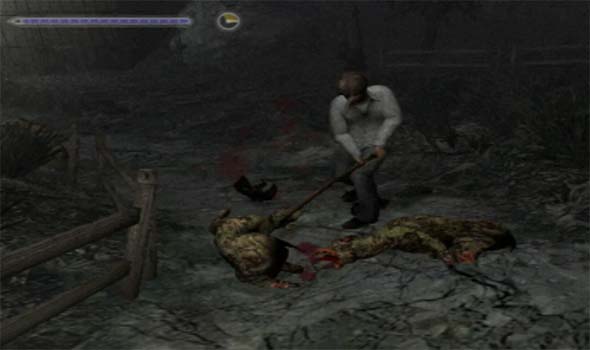
Movement and combat controls are radically changed from previous games in the series.
The most immediately obvious deviation is in movement and camera controls. The semi-first-person "tank" controls have been completely abandoned in favor of direct directional inputs, and the camera is significantly more limited than it has been in previous games. You can't snap the camera behind the character by holding the "look" button as you could do in previous games. Almost all camera angles are pre-set angles, and the player can usually only toggle between two possible camera angles in any given area.
This results in some very clumsy navigation of the environment, and it's very easy for the character to get turned around when camera angles flip. Most of the time, a camera change will go without a hitch, but there are a few frames in the game that consistently result in erratic and unpredictable movement. It happens most often when a camera change occurs concurrently with a change in direction of the character (to navigate around a corner or an obstacle). If the player's timing for changing the character's movement direction is not perfectly-timed, then the character ends up turning around, which can result in getting stuck in a loop between the two camera angles. This is the very reason that I prefer the tank controls. They may be a bit cumbersome, but at least they're consistent and always relative to a single frame of reference (the character's position in the world), rather than to an unpredictable camera.
The second major change is to combat. The game was designed to have a greater emphasis on melee combat, complete with new target-locking controls, a variety of breakable melee weapons, very limited ammunition for guns, and an on-screen meter for charging power attacks. The new movement controls do make it a bit easier to maneuver around enemies (especially multiple enemies), but only if you're in an open space and the camera angle doesn't go all wonky on you. The mechanics are serviceable, and I don't think they're as bad as some critics insist.
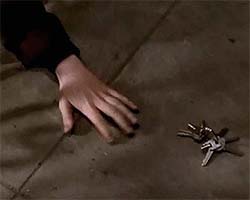
The designers were probably trying to mimic
the horror trope of fumbling for keys.
Inventory management is where things really start to get bad. Henry isn't a walking closet like the previous games' protagonists, and he has only a limited number of inventory slots. This is probably partly the result of the inventory being accessed in real-time by the directional buttons (which also might have played a role in the changes to the movement control scheme being entirely based up on the analog stick), in a desire to create a sense of frantically searching your pockets for a weapon or item while under pressure. It also adds more relevance to the Room 302 hub (another dramatic departure from previous games) by forcing you to go back to restock on supplies or swap out puzzle items.
But it's hindered by a lot of little mistakes... [More]
a5ccd49d-8af1-4839-8eb0-2796d3829980|6|4.5
Tags:Silent Hill, Silent Hill 4: the Room, Konami, Team Silent, KCET, Henry Townshend, Walter Sullivan, Eileen Galvin, room 302, horror, serial killer, murder, cult, occult, 21 Sacrements, sacrifice, ritual, ghost, escort quest, Alfred Hitchcock, retro review
|

| 12 | | | | | | | 60 | | 11 | | | | | | | 55 | | 10 | | | | | | | 50 | | 09 | | | | | | | 45 | | 08 | | | | | | | 40 | | 07 | | | | | | | 35 | | 06 | | | | | | | 30 | | 05 | | | | | | | 25 | | 04 | | | | | | | 20 | | 03 | | | | | | | 15 | | 02 | | | | | | | 10 | | 01 | | | | | | | 05 |
|